The 2021 Wheels and 4x4 Australia dual-cab ute megatest series continues with a comparison of the 2021 Jeep Gladiator Rubicon, Ford Ranger Raptor, Mazda BT-50 Thunder and Toyota HiLux Rugged X to find the best lifestyle ute
 |
|
These four utes are as much for recreation as they are for serious work
|
It took dual-cab ute manufacturers a while to catch on, but they’ve certainly done so now: “Hey, a lot of buyers seem to immediately modify their utes, so why don’t we just sell them pre-modified?” Genius.
The end result is the four utes you see here, the Ford Ranger Raptor, Jeep Gladiator Rubicon, Mazda BT-50 Thunder and Toyota HiLux Rugged X. We’ve dubbed these the ‘lifestyle’ quartet, primarily because they’re aimed at buyers who want to play just as much as they want to work. Arguably more.
For more in the Wheels/4×4 Australia ute comparison series, check out our head to head comparison of the Ford Ranger, Isuzu D-Max, Nissan Navara, Toyota Hilux and Mitsubishi Triton here and the Budget Utes compared stories here
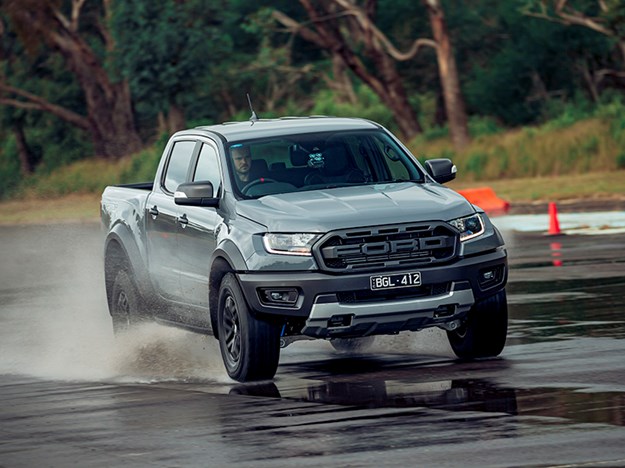 |
|
The Ford Ranger Raptor is wider than a Ford Ranger XLT
|
How they look is as important as what they can do and it’s the butch, beefed-up Ford Ranger Raptor that’s clearly been hitting the gym hardest. It’s a whopping 161mm wider than a Ranger XLT and wears chonky 285/70 BF Goodrich All-Terrains. Don’t think it’s all style and no substance, though, with a bespoke rear end and expensive Fox internal bypass shock absorbers.
Equally focused is the Jeep Gladiator Rubicon. Essentially a trayed version of the iconic Wrangler, the Rubicon is named after an iconic US off-road trail and equipped accordingly. Like the Ranger Raptor it scores Fox shocks (though not to the same specification as the Raptor) and aggressive BF Goodrich rubber, as well as a Rock-Trac on-demand 4×4 system, ultra-low 77.2:1 crawl ratio, electronic front sway-bar disconnect and Tru-Lok front and rear locking differentials. A Toorak Tractor this is not.
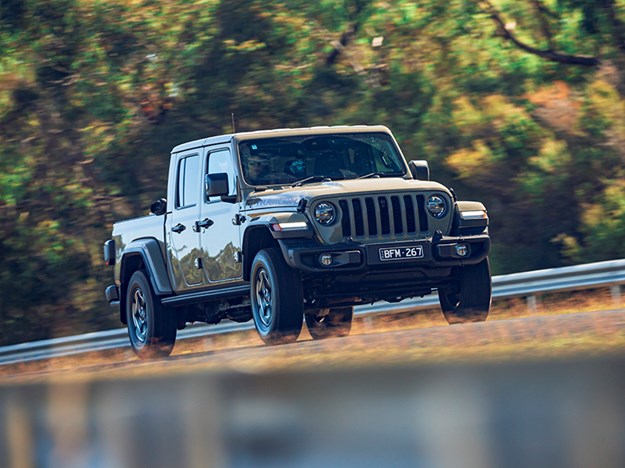 |
|
The Jeep Gladiator Rubicon is no Toorak Tractor
|
The Hilux Rugged X doesn’t take off-road adventuring quite so seriously but is enhanced with heavy duty front springs, a snorkel, recovery points at both ends, rock rails (side steps), heavy duty front and rear bumpers and a front bash plate. This is in addition to cosmetic enhancements like the new grille, outboard driving lights including front LED light bar and black guard extensions.
Our last contender is also the newest, the BT-50 Thunder being announced during our test, Mazda kindly providing a car ahead of launch. It essentially takes the range-topping GT and adds plenty of accessories, including a steel bullbar with LED lightbar, black 18-inch wheels, guard flares, side steps, a rear sports bar and electronic roller tonneau. Mazda claims the Thunder includes an extra $13,000 worth of value, but then it’s $10,000 more than the GT on which it’s based, at $65,990 for the six-speed manual and $68,990 for the automatic.
 |
|
Mazda’s BT-50 Thunder adds plenty of accessories to the range-topping GT
|
This still makes it our cheapest contender, especially as those prices are currently driveaway figures, though are expected to revert to RRP in due course. Even so, it’ll still narrowly undercut the auto-only Hilux Rugged X at $69,900 RRP, while the $76,450 Gladiator Rubicon and $77,190 Ranger Raptor are neck-and-neck.
The latter might be our most expensive participant but it also resists depreciation the best, Glass’s Guide suggesting it’ll retain 58 per cent of its value after three years, though that’s a figure the Hilux Rugged X matches. Our other two contenders are new enough that resale data does not yet exist, though the 50 per cent estimation for the BT-50’s D-Max twin provides some clue.
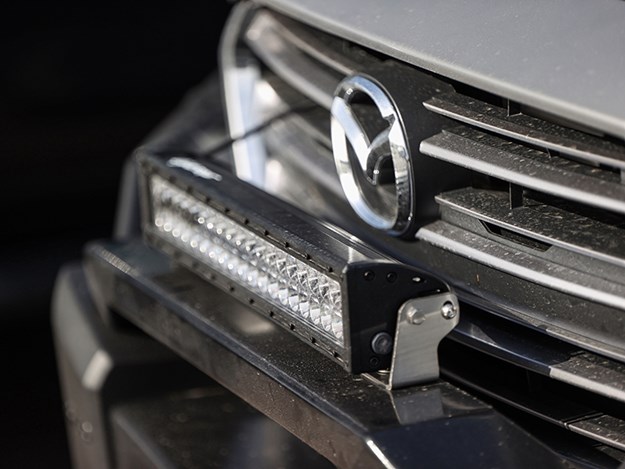 |
|
Mazda offers a five-year/unlimited kilometre warranty on the new ute
|
Mazda offers a five-year/unlimited-kilometre warranty as well as roadside assistance for the same period. Capped-price servicing covers the first seven services at 15,000km intervals, though the pricing varies depending on the exact distance covered – Mazda’s website provides greater detail. Ford likewise offers a five-year/unlimited-kilometre warranty and its roadside assistance program extends up to seven years as long as the Ranger Raptor is serviced at an official Ford dealership. The first 12 services are capped in price with work required every 12 months or 15,000km; the first four are $299 and prices increase from there.
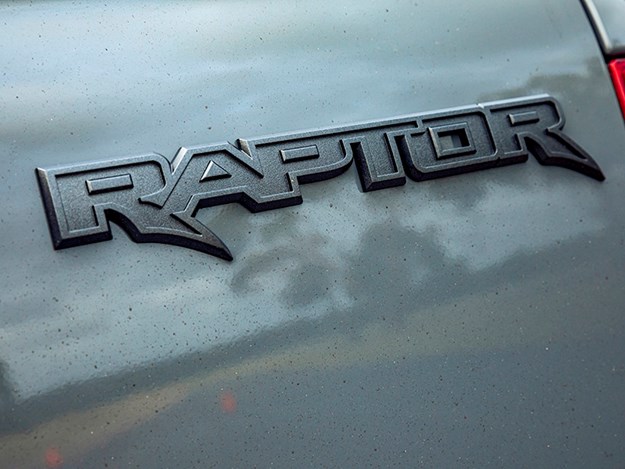 |
|
Ford will offer a roadside assistance package for up to seven years, as long as the vehicle is serviced at a Fort-approved centre
|
Like these two, Toyota has a five-year/unlimited-kilometre warranty, but as long as you stick to the servicing schedule an extra two years of driveline warranty will be tacked on for a total of seven years. The first four services are capped at $250 each but are required at intervals of six months or 10,000km. Toyota also charges for its roadside assistance program, which starts at $89 per year.
Jeep warranties the Gladiator Rubicon for five years/100,000km and offers a roadside assistance program for the same period, though it will extend this by 12 months each time the vehicle is serviced at an official Jeep dealership. The first five services are capped at $399 and occur at intervals of 12,000km or 12 months.
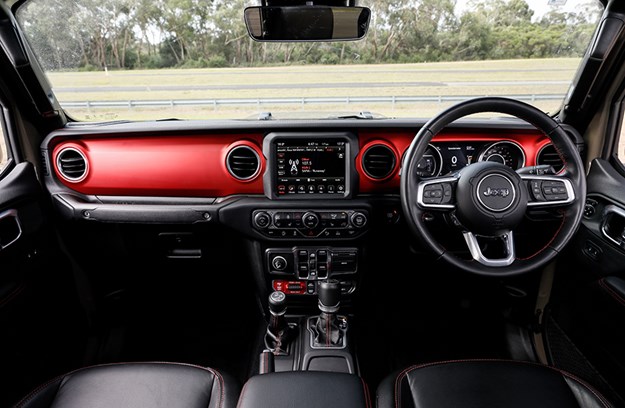 |
|
Unique ergonomic solutions abound inside the Jeep Gladiator Rubicon
|
Inside the Gladiator has a sense of adventure to its layout which requires some unique ergonomic solutions. For instance, the removable doors necessitate the repositioning of the window switches to the centre console. The Rubicon-specific leather seats and comfortable enough though the raised centre back rest eats into elbow room in the rear. Standard equipment includes keyless entry and start, parking sensors and rear-view camera, dual-zone climate control, heated side mirrors and tyre pressure monitoring, but the elephant in the room is the Gladiator’s three-star ANCAP safety rating.
Every other contender has a five-star safety rating, but there are a couple of caveats. The Raptor’s five-star rating is a legacy of the Ranger’s 2011 test, which is extremely out of date. However, Ford has continually updated its popular ute with the latest active safety toys like autonomous emergency braking, adaptive cruise, lane keep assist and lane departure warning, but rear cross-traffic alert and blind-spot monitoring are absent.
The Ranger’s cabin architecture might be ageing but the Raptor shines with simply superb front seats – the hard, flat rears are less impressive – and the leather-wrapped steering wheel with straight-ahead marker and long metal paddle shifters. Other features include dual-zone climate control, auto wipers and headlights, a 230v power outlet in the rear (but no vents or USB ports) and keyless entry and start.
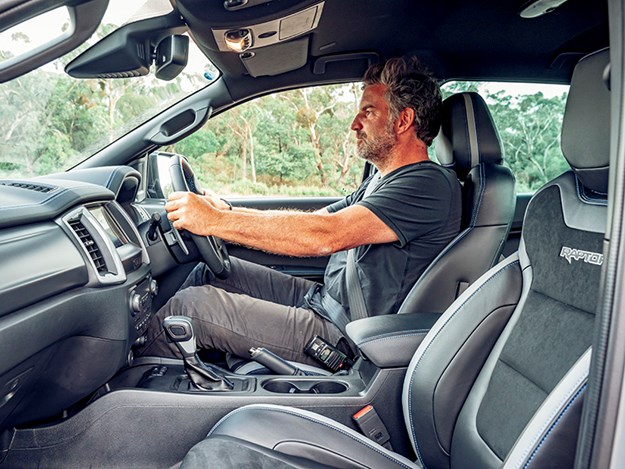 |
|
The front seats in the Ford Ranger Raptor are simply superb
|
The next caveat concerns the Mazda. The BT-50 was awarded a five-star safety rating in 2020 but the Thunder’s modifications prevent it carrying over. Nevertheless, it still packs every active safety feature under the sun, including AEB, active cruise (auto only), lane keep assist, lane departure warning, blind-spot monitoring and rear cross-traffic alert.
Its leather front seats offer excellent bolstering but are a bit short on under-thigh support; both are heated, but only the driver’s has power adjustment. Its GT base means it’s packed with kit, including auto wipers and headlights, dual-zone climate, keyless entry and go and LED headlights.
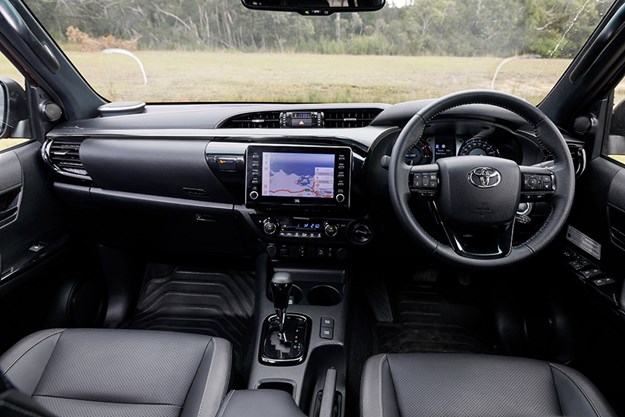 |
|
The Hilux has a five-star ANCAP safety rating
|
No asterisks need be applied to the Toyota, the Hilux receiving its five-star ANCAP rating in 2019. It boasts seven airbags and plenty of active safety gear including adaptive cruise, lane-keep assist and AEB but also drops the ball in terms of equipment compared to its competitors. There’s only single-zone climate control, no auto wipers and no blind-spot monitoring or rear cross-traffic alert. You’d hope that the flagship Hilux would be fully loaded.
The front seats offer decent support and legroom but the rears are hard and flat with less legroom than rivals. On the plus side there’s plenty of leather, heated front seats with power operation for the driver as well as auto LED headlights and keyless entry and start. The most recent Hilux facelift addressed some infotainment shortfalls and we’re glad to see the reintroduction of volume knobs rather than touch controls.
The 8.0-inch screen offers smartphone mirroring and myToyota app integration which is a handy place to store warranty and servicing information while also offering owners a 4c/litre fuel discount at Ampol service stations. Navigating between different infotainment functions is simple thanks to button shortcuts surrounding the screen and the instrument cluster now features a digital speed readout. Connecting to Bluetooth is easy initially, though subsequent connections take about 30 seconds, but the Rugged X’s JBL sound system is easily one of the better dual-cab offerings with good clarity and strong bass.
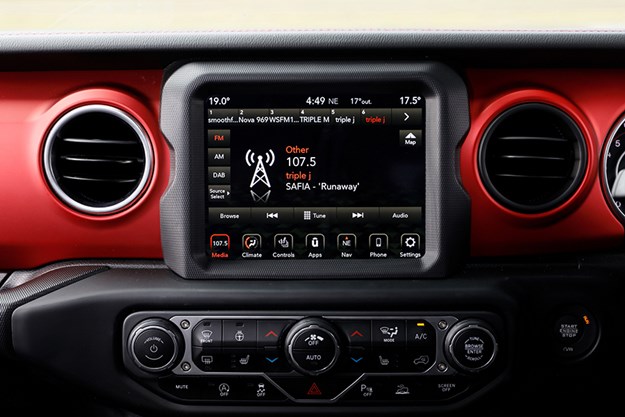 |
|
Jeep’s Uconnect infotainment system boasts a swathe off-road displays and accessory gadgets
|
Jeep’s 8.4-inch Uconnect infotainment system features a large amount of functionality and customisation. There are configurable shortcuts along the bottom of the screen depending on what features are used most, while the system stocks a swathe of off-road displays and accessory gauges for the hardcore enthusiast.
There are two USB-A ports, one USB-C socket and one 12-volt outlet for connecting your own gear, and there is also space to connect auxiliary switches should you wish to accessorise. The infotainment system caters to Apple CarPlay and Android Auto users – albeit wired – and will also tune to digital radio. The standard satellite navigation offers clear, detailed maps and is easy to use. Many of the car’s functions such as heated seats and climate control are controlled using the touchscreen.
Voice command is quick to understand spoken instructions and will engage Apple’s Siri if an iPhone is connected, rather than rely on the native system. Audio and media controls mounted on the back of the steering wheel take some learning to understand which button does what.
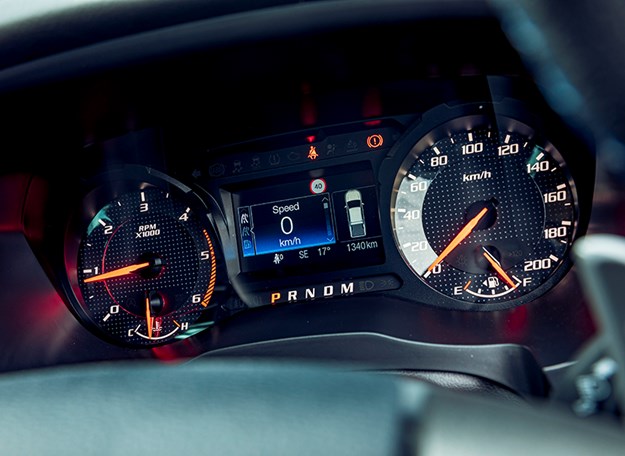 |
|
The Ford Ranger Raptor uses voice command
|
Voice command is also a genuine helper in the Ranger Raptor, which uses Ford’s ubiquitous SYNC3 infotainment system. It displays through an 8.0-inch touchscreen and incorporates smartphone mirroring and a FordPass app that integrates with the infotainment to control functions like remote start, vehicle locator, fuel level, vehicle health check and live traffic updates. Using SYNC3 is straightforward but certain vehicles can suffer with input lag, but it’s a known problem that can usually be fixed with a system reset. Bluetooth connection is quick, the sound system is strong, there are two USB-A inputs and a 12-volt outlet up front with a 230v outlet on the back of the centre console.
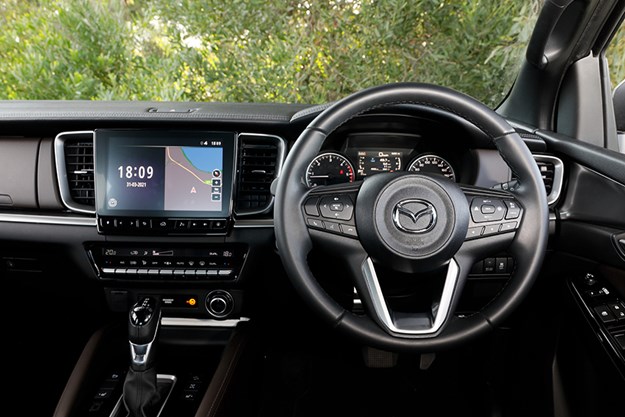 |
|
The Mazda BT-50 Thunder borrows its infotainment unit from Isuzu
|
The BT-50 Thunder shares its equipment specification with the GT. This means a 9.0-inch touchscreen infotainment unit borrowed from Isuzu that has Apple CarPlay/Android Auto capabilities as well as native satellite navigation and digital radio. It presents as more of an aftermarket solution than you’d like from Mazda, whose in-house MZD Connect system is one of the best in the business. That said, all the bases are covered with quick-select shortcuts to different functions along the bottom of the screen. Annoyingly, the screen is prone to catching glare, which will no doubt annoy some buyers.
Smartphone mirroring is wireless, though there’s no wireless phone charging so you’ll have to plug in to charge up anyway. Smartphone mirroring is simple to connect initially, and the car will ask if you want to continue using it after re-entering. Front-row occupants are covered by one USB-A port and one 12-volt power outlet. There’s also dual-zone climate control and an eight-speaker stereo system to keep passengers happy.
.jpg) |
|
The Mazda BT-50 Thunder’s infotainment system has all the bases covered
|
It’s not only the infotainment that the BT-50 shares with the Isuzu D-Max. As we’ve alluded to several times, under-the-skin the two are nigh-on identical. The Thunder is a slight exception as its accessories add almost 200kg over a BT-50 GT and almost 100kg over a range-topping D-Max X-Terrain to the detriment of performance and dynamics.
The 3.0-litre turbo-diesel is a strong, torquey unit but it has a lot of ute to motivate, taking 10.84sec to reach 100km/h and 6.3sec from 60-100km/h as an overtaking test. The engine becomes vocal and even raucous above 3500rpm with quite a narrow powerband, the ride isn’t super polished and the electronic stability systems are a little over-zealous, but it stops impressively for a dual-cab, taking 38.82m from 100-0km/h in the dry and an average of 52.74m over three runs in the wet, the average used to avoid surface inconsistency.
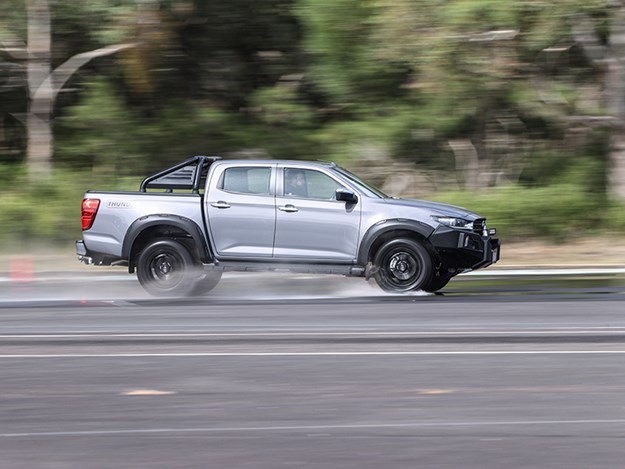 |
|
The Mazda BT-50 Thunder is a strong, torquey unit with a 3.0-litre turbo-diesel engine
|
Under acceleration the Ranger Raptor is virtually identical to the BT-50, being a solitary hundredth of a second slower to 100km/h (10.85sec) but a tenth quicker from 60-100km/h, the benefit of having 10 gears instead of six. Ford’s 2.0-litre twin-turbo diesel is an impressive performer in lighter Ranger variants but it’s out of its depth when tasked with 2332kg of Raptor. The massive BF Goodrich rubber doesn’t help, either, and is a genuine liability under brakes, the Ford taking a truly appalling 46.16m to stop from 100km/h in the dry and a diabolical 61.45m in the wet.
Yet it’s not the worst. The Gladiator Rubicon, wearing the same rubber as the Ranger Raptor, takes a slightly better (damning with faint praise) 44.2m to stop in the dry but a whopping 66m in the wet. It feels to sail across the surface like it’s coated in Teflon, accompanied by the furious yet fruitless attempts of the ABS system to find grip.
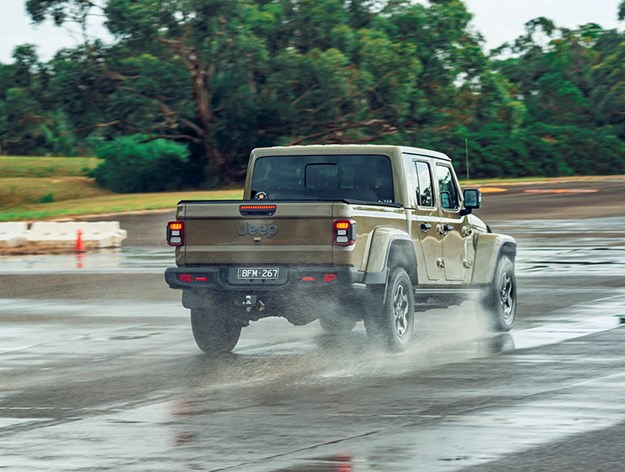 |
|
The Jeep Gladiator Rubicon is capable of genuine pace
|
Of course, tyres make a huge difference in these sort of tests and this is the price to be paid for off-road prowess; that in itself is fine, as long as buyers and drivers understand the level of compromise that this focused rubber requires. Put it this way: at the point at which the BT-50 Thunder has stopped in the wet, the Gladiator is still traveling 44.8km/h.
The Jeep is somewhat more alarming as its capable of genuine pace, the grunty 209kW/347Nm 3.6-litre V6 propelling it to 100km/h in 9.18sec and from 0-100km/h in 5.2sec, accompanied by a howl that isn’t a million miles away from a Nissan 370Z. Its heavy off-road focus costs it dynamically – there’s a reason no sports cars use solid axles at both ends – with lifeless steering, ponderous handling and a loose, top-heavy feeling through tight turns. The on-road ride is poor, but switch to gravel and the situation improves, the Gladiator shrugging off road imperfections and the ESC keeping everything pointed in the right direction.
A predilection towards the rough stuff doesn’t automatically mean sacrificing on-road manners, though. Ford’s flagship Raptor is head and shoulders above the rest dynamically. Its substantial weight and All-Terrain tyres cost it in terms of outright handling, but its tuning instils a sense of confidence combined with truly plush ride quality.
.jpg) |
|
The Ford Ranger Raptor is head and shoulders above the rest dynamically
|
The Hilux is a strong performer, its upgrade 150kW/500Nm engine feeling enthusiastically grunty. Granted, 0-100km/h in 10.7sec isn’t going to set too many hearts racing but with competitive overtaking acceleration (60-100km/h in 5.8sec) it feels stronger than the numbers suggest. It struggles to arrest itself as impressively, though; its 39.7m dry effort from 100-0km/h is ok but the 57.5m wet result is poor.
Previous versions of Toyota’s best-selling ute have seemed incapable of possessing both decent dynamics and a comfy ride, but the recent facelift’s steering modifications make it quite a nimble handler, cornering with accuracy and control. You could almost call it fun. Away from smooth roads, however, the stiff suspension results in a stiff, jittery ride that feels agricultural compared to the far more sophisticated Raptor. Road and tyre noise are also ever-present and the ESC is far too intrusive on loose surfaces. There are dual-cabs with worse ride and refinement issues, but none that command the elevated price tag of the Hilux.
 |
|
The Toyota Hilux Rugged X is a strong performer
|
The script flips completely off-road. No vehicle is more of a candidate for larger tyres than the Rugged X, but that’s its only letdown off-road. The Hilux traction control is first class, pulling it through everything even on small highway tyres, and 4×4 activation was quick and easy with excellent low-range gearing.
But even the Toyota’s excellence is no match for the Jeep. In terms of pure off-road prowess, you’d be hard-pressed to find a more capable vehicle than the Gladiator Rubicon. Front and rear locking differentials, tremendous low-range gearing, a disconnecting front anti-roll bar and Mud Terrain tyres are a recipe for success. The Gladiator is a bit long for some tight tracks, but it never appears to even lose traction. Engaging 4×4 is simple via an old-school lever and the Jeep is only some larger tyres and a slight suspension lift away from being completely unstoppable off-road.
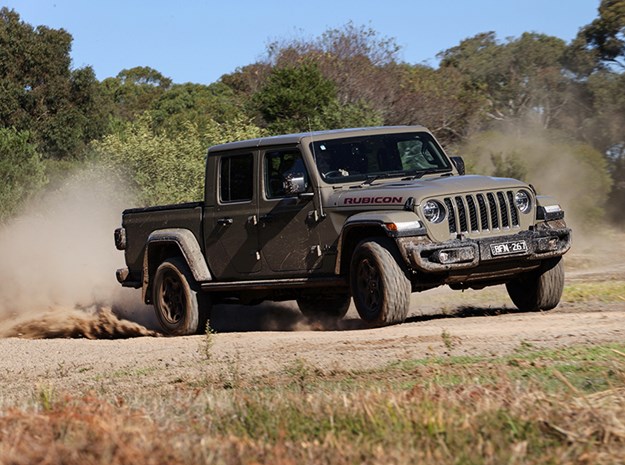 |
|
In terms of pure off-road prowess, you’d be hard-pressed to find a more capable vehicle than the Gladiator Rubicon.
|
Undermining the Raptor’s off-road ability is its width. This not only hampers it on narrow tracks but it also means it won’t sit in the wheel ruts of other vehicles. Apart from this it makes a strong case, with easy 4×4 engagement, various traction control modes to play with, those fantastic seats and great traction thanks to those chunky tyres. While it’s not as outright capable as the Jeep it’s still very accomplished and an absolute hoot to drive, eating washouts for breakfast.
Mazda has pitched the Thunder more as a weekender than a hardcore off-roader but its D-Max underpinnings mean it’s still capable. The traction control can’t match the Hilux but the rear diff lock gets you out of trouble and the engine produces plenty of torque down low. Only the firm suspension offers room for improvement, something easily fixed via the aftermarket.
Those added extras reduce the Thunder’s payload to 887kg but that’s still the best here and while it sports a full plastic tub liner, two tie-down points, an LED work light and electronic hard tonneau, the latter’s storage cartridge cuts load length from 1455mm to 1240mm and prevents the tailgate closing when our 500kg payload test pallet is loaded.
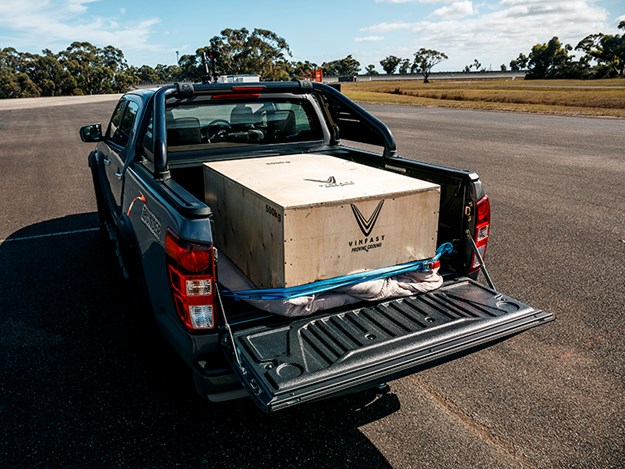 |
|
Mazda has pitched the Thunder more as a weekender than a hardcore off-roader but its D-Max underpinnings mean it’s still capable.
|
The powertrain doesn’t struggle with the extra weight, though 4.4sec from 20-60km/h is the slowest on test, but the front-end can feel a little nervous. Attach a trailer, in this case carrying Street Machine’s Turbo Taxi, and the Thunder takes 7.3sec to accelerate from 20-60km/h. It pulls well even with the extra weight and the steering doesn’t suffer to the same degree as when loaded directly.
Both the Hilux Rugged X and Ranger Raptor are big old beasts, weighing in 2316kg and 2342kg respectively. As such, their payloads are limited to 734kg and 748kg, which means our 500kg pallet and a couple of passengers would have them very close to their allowable Gross Vehicle Mass. The Ranger’s tub is well-proportioned and wider than the category average, while also including a 12-volt power supply, spring-loaded tailgate, load area lighting and spray-in liner with four tie-down points.
It accelerates from 20-60km/h in 4.2sec when loaded, the transmission shifting well under hard acceleration but struggling to retain its composure in normal driving. The Raptor’s lovely ride quality also vanishes when laden and it suffers from poor body control. It’s a similar story when towing; its rear end isn’t designed for heavy loads and sagging significantly when a trailer is attached, evidenced by its 2500kg towing maximum, though it remains relatively brisk with a 6.7sec result from 20-60km/h.
 |
|
The Ford Ranger Raptor’s lovely ride quality also vanishes when laden and it suffers from poor body control.
|
The Gladiator shouldn’t be the first choice for those who need practicality. Its tub has heaps of tie-down options (four fixed, four adjustable), two work lights and a spray-in tub liner, but the space is on the shallow side and the gate width is just 1260mm. A 620kg payload also hampers it and while the engine’s grunt shrugs off the 500kg pallet, taking just 3.4sec to accelerate from 20-60km/h, its relatively lack of torque makes it tricker on the move and the suspension pitches forward dramatically over bumps.
A trailer doesn’t faze it either with a benchmark 6.3sec 20-60km/h result, but the gearbox is a handicap, constantly holding the engine at 5000rpm rather than smoothly shifting to the next year. The live-axle set-up also doesn’t help, requiring constant steering input on the move. One for occasional towing duties only.
 |
|
A Trailer doesn’t phase the Jeep Gladiator Rubicon
|
When it comes to load lugging, the Toyota is the clear winner from this group. The tub is about category average with four tie-down points and a plastic liner, though a soft-drop tailgate would be nice at this price point (it’s standard on the GWM Ute…). Acceleration is reasonable with a 4.2sec 20-60km/h effort, but out on the road it feels balanced, the rear barely dipping when laden. This excellence continues when towing with impressive manners both under acceleration (7.2sec 20-60km/h) and in corners.
When all said and done, the Toyota Hilux Rugged X is also the winner of this test, but let’s start from the other end. The Jeep Gladiator Rubicon scores the wooden spoon, but then given its focus this isn’t surprising. It’s designed to dominate off-road and that’s exactly what it does, but just be aware that there are sacrifices to be made in terms of on-road dynamics, practicality and safety. Cool thing, though.
Again, a holistic dual-cab view doesn’t play to the Ranger Raptor’s strengths. If you want a workhorse, you’re much better served with a regular Ranger like an XLT or a Wildtrak, but if you want a weekender to tow and jetski and carry a family then the Raptor is brilliant. It offers unparalleled ride comfort, plenty of kit, solid on-road dynamics and unbeatable high-speed, loose-surface behaviour. If only it had a beefier engine, but for that we’ll need to wait for next year’s all-new Ranger.
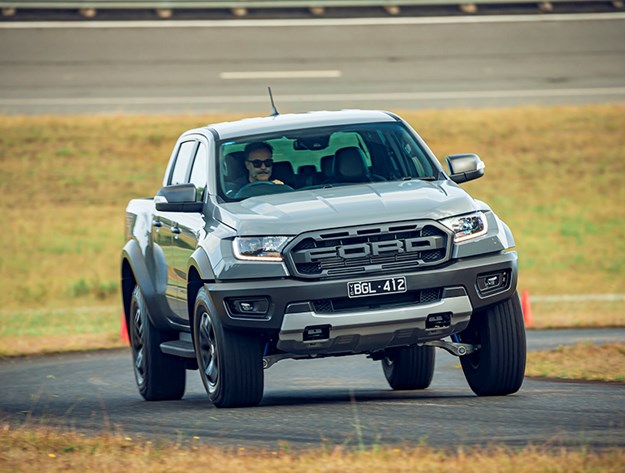 |
|
The Ford Ranger Raptor is brilliant as a weekender
|
Best of the rest is the Thunder, but this position is more down to the fundamental excellence of the BT-50 package rather than any Thunder-specific attributes. In fact, you could argue that the Thunder is Mazda’s ute at its weakest. The accessories might (MIGHT!) add some street-cred but they also negatively impact performance, dynamics, economy and value. We’d stick with an XTR or GT and add your own accessories.
This leaves the Toyota Hilux Rugged X as the top dog but it’s not a spot it occupies by default. It could and should be better in terms of dynamics, comfort and equipment, but it’s brilliant off-road, the new engine is a powerful unit, it’s unfazed by payloads or towing and has outstanding resale. The tweaks made as part of the recent update have elevated it to a level that’s worthy of its reputation.
Verdict
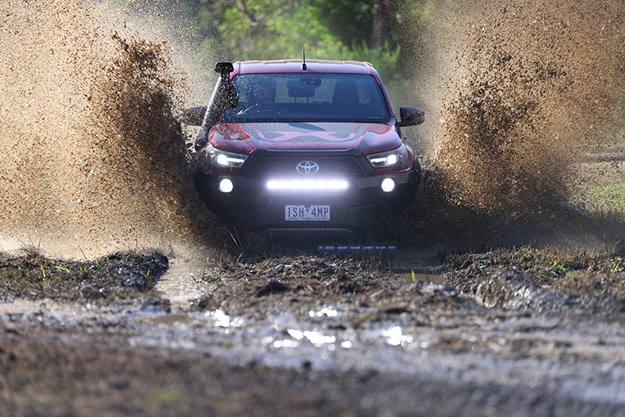 |
|
The Toyota Hilux Rugged made a splash with our reviewers
|
1st – Toyota Hilux Rugged X 7.5/10
Likes: great off road; powerful engine; work horse ability
Dislikes: under-specced; on-road dynamics
2nd – Mazda BT-50 Thunder 7.5/10
Likes: impressive all-rounder;
Dislikes: Thunder additions subtract more than they add
3rd – Ford Ranger Raptor 7.5/10
Likes: ride quality; fun factor; looks
Dislikes: needs more engine; towing/payload struggles
4th – Jeep Gladiator Rubicon 6.5/10
Likes: unbelievable off road; cool factor; grunty engine
Dislikes: heavily compromised on road; safety
Specifications
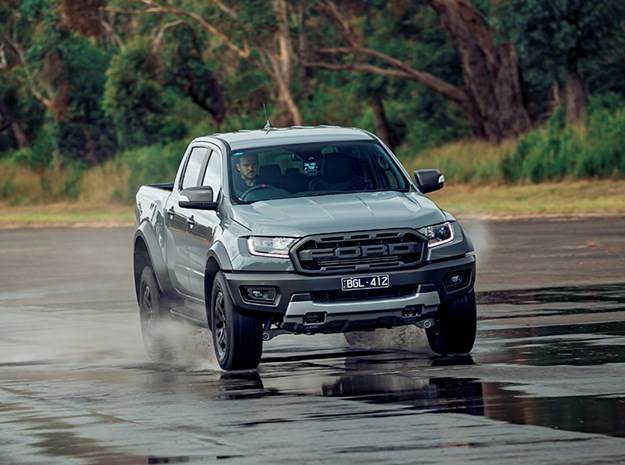 |
|
Ford Ranger Raptor
|
Ford Ranger Raptor
Body: 4-door, 5-seat ute
Drive: rear-/all-wheel drive
Engine: 1995cc four-cylinder diesel, DOHC, 16v, twin-turbo
Bore/stroke: 84.0 x 90.0mm
Compression: 16:1
Power: 157kW @ 3750rpm
Torque: 500Nm @1750-2000rpm
Fuel economy: 8.2L/100km (claimed/combined)
0-100km/h: 10.85sec (tested)
Weight: 2342kg
Power/weight: 67kW/tonne
Transmission: 10-speed automatic
Towing: 2500kg (braked)
Suspension: double wishbones, coil springs, anti-roll bar (f) Watts-link, coil springs (r)
L/W/H: 5398/2028/1873mm
Wheelbase: 3220mm
Tracks: 1710mm (f/r)
Steering: electrically assisted rack-and-pinion
Brakes: 332mm ventilated discs, 2-piston calipers (f) 332mm ventilated discs, single-piston calipers (r)
Wheels: 17 x 8.5-inch
Tyres: 285/70 R17 116/113S BFGoodrich All-Terrain T/A KO2
Price: $77,190
.jpg) |
|
Jeep Gladiator Rubicon
|
Jeep Gladiator Rubicon
Body: 4-door, 5-seat ute
Drive: rear-/all-wheel
Engine: 3604cc V6, DOHC, 24v
Bore/stroke: 96.0 x 83.0mm
Compression: 11:3:1
Power: 209kW @ 6400rpm
Torque: 347Nm @ 4100rpm
Fuel economy: 12.4L/100km (claimed/combined)
0-100km/h: 9.18sec (tested)
Weight: 2215kg
Power/weight: 94kW/tonne
Transmission: 8-speed automatic
Towing: 750kg (unbraked) 2721kg (braked)
Suspension: solid axle, link coil, leading arms, track bar, coil springs, stabilizer bar (f) solid axle, link coil, trailing arms, track bar, coil springs, stabilizer bar (r)
L/W/H: 5591/1894/1909mm
Wheelbase: 3488mm
Tracks: 1636mm (f/r)
Steering: hydraulically assisted rack-and-pinion
Brakes: 330mm ventilated discs, 2-piston calipers (f) 345mm ventilated discs, single-piston calipers (r)
Wheels: 17 x 7.5-inch (f/r)
Tyres: 255/75 R17 111/1080 BFGoodrich Mud Terrain T/A KM2
Price: $76,450
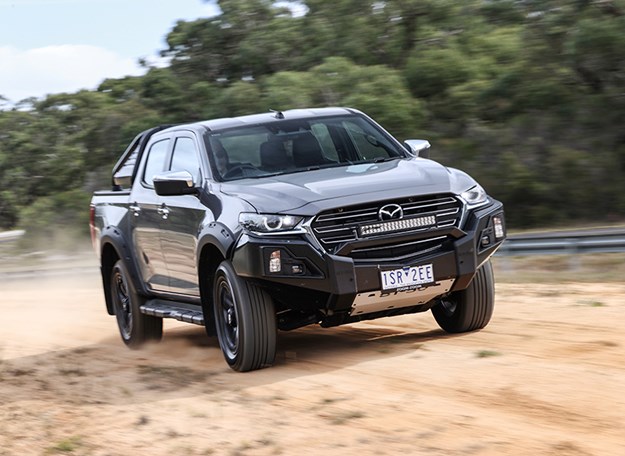 |
|
Mazda BT-50
|
Mazda BT-50 Thunder
Body: 4-door, 5-seat ute
Drive: rear-/all-wheel
Engine: 2999cc inline-4cyl diesel, DOHC, 16v, turbo
Power: 140kW @ 3600rpm
Torque: 450Nm @ 1600-2600rpm
Fuel economy: 8.0L/100km (auto combined/claimed)
0-100km/h: 10.84sec (tested)
Weight: 2213kg
Power/weight: 63kW/tonne
Transmission: 6-speed automatic
Towing: 750kg (unbraked), 3500kg (braked)
Payload: 887kg
L/W/H: 5470/1880/1790mm
Wheelbase: 3125mm
Tracks: 1570mm (f/r)
Suspension: struts, A-arms, coil springs, anti-roll bar (f); leaf springs, dampers, anti-roll bar (r)
Steering: electrically assisted rack-and-pinion
Brakes: 320mm ventilated discs, single-piston calipers (f); 295mm rear drums (r)
Wheels: 18 x 7.5-inch (f/r)
Tyres: 265/60 R18 110T (f/r) Bridgestone Dueler H/T 684II
Price: $65,990 (manual), $68,990 (auto)
 |
|
Toyota Hilux Rugged X
|
Toyota Hilux Rugged X
Body: 4-door, 5-seat ute
Drive: rear-/all-wheel
Engine: 2755cc inline-4cyl diesel, DOHC, 16v, turbo
Bore/stroke: 92.0 x 103.6mm
Compression: 15.6:1
Power: 150kW @ 3400rpm
Torque: 500Nm @ 2800rpm
Fuel economy: 8.4L/100km (claimed/combined)
0-100km/h: 10.7sec (tested)
Weight: 2316kg
Power/weight:65kW/tonne
Transmission: 6-speed automatic
Towing: 750kg (unbraked) 3500kg (unbraked)
Suspension: double wishbones, coil springs, anti-roll bar (f); live axle; leaf spring (r)
L/W/H: 5350/1935/1815mm
Wheelbase: 3085mm
Tracks: 1535/1550mm (f/r)
Steering: hydraulically assisted rack-and-pinion
Brakes: 319mm ventilated disc, single-piston calipers (f) 295mm drums (r)
Wheels: 18 x 7.5-inch (f/r)
Tyres: 265/65 R17 112S AT25 Dunlop Grandtrek
Price: $69,990
Photography: Ellen Dewar, Alastair Brook, Cristian Brunelli

